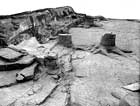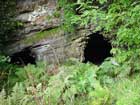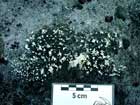Carboniferous
362-290 Ma ( Arran at the8 degrees North)
 Carboniferous
rocks reflect a time when tropical conditions prevailed with occasional
igneous activity. Expansive shallow seas, deltas and swamps covered the
Midland Valley of Scotland and repeated fluctuations in sea level gave
rise to the Milankovitch cycles of sedimentation typified by the Period. Carboniferous
rocks reflect a time when tropical conditions prevailed with occasional
igneous activity. Expansive shallow seas, deltas and swamps covered the
Midland Valley of Scotland and repeated fluctuations in sea level gave
rise to the Milankovitch cycles of sedimentation typified by the Period.
 Arran,
being on the edge of such a basin, has a variable thickness of Carboniferous
rocks from the east to the west due to changes in rates of basin linked
subsidence. Although better represented on the mainland, nearly 900m thickness
of Carboniferous rocks on Arran can be seen in the northeast along the
shore at Corrie. The first sandstones and conglomerates of the Period,
known as the Kinneswood Formation, lie on the errosive base of the Old
Red Sandtone. The famous locality at Hutton's unconformity,
is where Carboniferous rocks of the Kinneswood Formation overly Dalradian
Rocks (unconformity is shown above). Arran,
being on the edge of such a basin, has a variable thickness of Carboniferous
rocks from the east to the west due to changes in rates of basin linked
subsidence. Although better represented on the mainland, nearly 900m thickness
of Carboniferous rocks on Arran can be seen in the northeast along the
shore at Corrie. The first sandstones and conglomerates of the Period,
known as the Kinneswood Formation, lie on the errosive base of the Old
Red Sandtone. The famous locality at Hutton's unconformity,
is where Carboniferous rocks of the Kinneswood Formation overly Dalradian
Rocks (unconformity is shown above).
  Moving
south along the shore the basalt lavas and agglomerates of the Clyde Plateau
Volcanic Formation eventually give way to the fossiliferous sandstones,
organic rich mudstones and limestones for which the Carboniferous is so
well known. Arran, however, does lack the coal measures so ubiquitous
in the Carboniferous of the mainland. The only known coal on Arran outcrops
on the shore at Laggan and was once mined for the production of salt. Moving
south along the shore the basalt lavas and agglomerates of the Clyde Plateau
Volcanic Formation eventually give way to the fossiliferous sandstones,
organic rich mudstones and limestones for which the Carboniferous is so
well known. Arran, however, does lack the coal measures so ubiquitous
in the Carboniferous of the mainland. The only known coal on Arran outcrops
on the shore at Laggan and was once mined for the production of salt.
|

